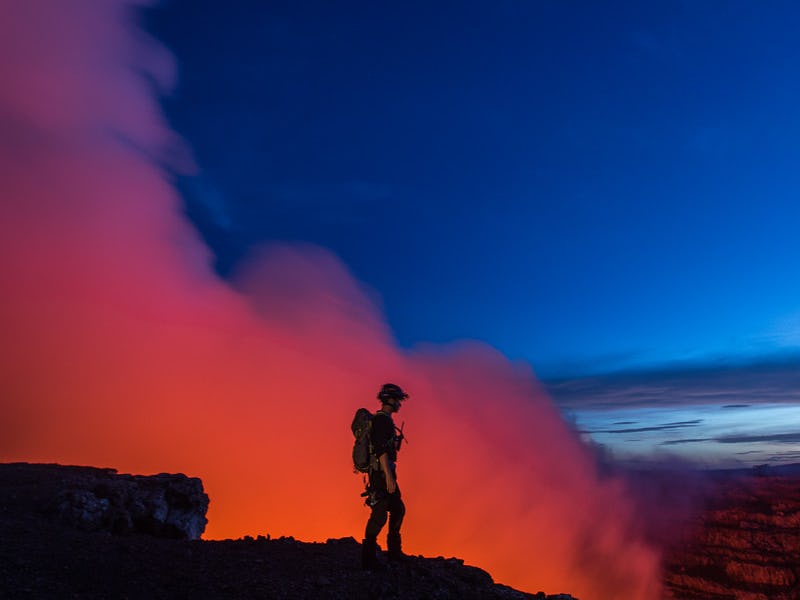Nicaragua's Internet of Things is Volcanic
Think of it as a thermostat, but incredibly dangerous and big and nothing like a thermostat.

Last week, adventurer Sam Cossman descended 1,200 feet into the mouth of Masaya, an active volcano in Nicaragua, in order to connect it to the internet.
Well, sort of. The project involved installing an array of more than 80 sensors that will measure temperature, humidity, pressure, carbon dioxide, and other factors and transmit the data in real time. Continuous monitoring of volcanoes is nothing new, contrary to what the publicity materials for the stunt suggest, although it’s possible that this project is exceptional in the sheer volume of data that will be collected.
Cossman got the idea for a project from the owner of a bed and breakfast near the volcano, who sent him a link to a video of the lava lake, he tells GE’s media team in an interview. “I was blown away by what I saw. It’s one thing to see a lava lake — there are maybe 10 permanent ones in the world — but this one was very unique,” he says. “The lake was not just a bubbling, churning pit of magma. This one looked like a waterfall more than a lake. It was a one-directional flow of lava going over a cliff. It hinted on the size of the magma chamber below.”
The adventurer was in the spotlight a couple years ago when a YouTube video of him descending into a volcano in Vanuatu attracted millions of views. He’s the founder of Qwake, a company that hopes to use technology and media to inspire positive change.
“Qwake Labs was born out of the belief that exploration is the engine that drives innovation,” according to the website. “Simply put, extreme exploration inspires unlikely solutions to unsolved problems. By building things others don’t we seek to expand universal knowledge.”
Guillermo Caravantes, a volcanologist with the project who wrote his Ph.D. about the Masaya volcano and has studied it for eight years, is excited for the potential. “It’s a pleasure for me to be here, because this is such an exciting expedition,” he says in a Facebook video. “It’s a pleasure to do volcanology this way. We have all this support.”
The real goal, he says, is to improve safety for the millions of people who could be at risk in the event of a major eruption. The volcano overlooks the city of Masaya, as well as the capital, Managua. This project will give scientists access to more and better data, akin to a doctor being able to observe and monitor a patient’s vital signs in real time.
Of course, any scientist would be excited for a well-resourced expedition that offers new access and data to their object of study. But will this proliferation of information and attention lead to earlier warning in the event of an eruption?
Jessica Ball, a volcanologist with the U.S. Geological Survey, has her doubts. A good use of resources would support the monitoring work already happening at the volcano, “rather than jetting in, installing a few instruments and then wandering off to play with the data,” she tells Inverse in an email. Masaya is currently monitored by the Nicaraguan government, which releases frequent activity reports based off of sensor data and observations.
The data collected in the first three months will be compiled by expedition sponsor General Electric, using the company’s Predix software platform. The plan is to analyse the data with the help of artificial intelligence systems, and also to release it publicly for developers and scientists to use and interpret.
But the truth is that you won’t be able to build an eruption early warning system off of three months data, no matter how extensive it is. “Volcano monitoring works best when you take into account past behavior of a volcano, and the longer the record is, the better,” says Ball. It “might be useful for a particular event that happens during that period, but in the long-term it’s less valuable, like trying to analyze a painting by only looking at one corner — while it’s being painted!”
It’s also not obvious that this big data, open-source approach will offer significant benefits over monitoring that’s already in place, she says. “If the group means they hope developers will look at what data is being collected and how and try to come up with easier, more efficient, more secure, etc. ways to collect, process and transmit it, well, that could be useful. However, if they mean they’re releasing the data to everyone and saying ‘have at it’ to predict volcanic behavior, that’s dangerous (not to mention insulting to the scientists who are already working there).”
“Volcanologists spend their entire careers trying to analyze and forecast volcanic behavior and even the best of us are still learning how to interpret the data we collect,” Ball continued. “Ignoring decades of expertise in favor of crowd-sourcing a prediction of volcanic behavior — which could have severe consequences for the safety of local people and their economic interests — is an irresponsible attitude at best.”
All in all, Ball admits it’s great that this volcano is getting an extensive monitoring system. But she stressed that data should support existing research without trying to usurp it. How this plays out remains to be seen, but the folks involved should be wary of “glossing over what seem to be boring, tedious, un-flashy monitoring efforts in favor of a very 19th-century-style ‘adventurer’ approach to things,” she says.